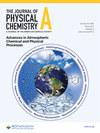Photodissociation Dynamics of Hydrated Ni2+ Clusters: Ni2+(H2O)n (n = 4−7)
IF 2.8
2区 化学
Q3 CHEMISTRY, PHYSICAL
引用次数: 30
Abstract
Hydrated divalent nickel clusters, Ni2+(H2O)n (n = 4?7), have been generated through electrospray ionization and studied with laser photofragment spectroscopy. Clusters containing six and seven water molecules dissociate by loss of either one or two water molecules. In contrast, Ni2+(H2O)4 dissociates via charge reduction, producing H3O+ + NiOH+(H2O)2. The modest kinetic energy release in the H3O+ product is in agreement with a salt-bridge dissociation mechanism. Observed dissociation cross-sections indicate that the hexahydrated species is the probable carrier for nickel's aqueous absorption spectrum.
水合Ni2+簇的光解动力学:Ni2+(H2O)n (n = 4−7)
采用电喷雾电离法制备了水合二价镍簇Ni2+(H2O)n (n = 4?7),并用激光光碎片光谱对其进行了研究。含有6个或7个水分子的团簇由于失去一个或两个水分子而解离。相反,Ni2+(H2O)4通过电荷还原离解,生成h30o + + NiOH+(H2O)2。h30 +产物的适度动能释放符合盐桥离解机制。观察到的解离截面表明,六水合物可能是镍水吸收光谱的载体。
本文章由计算机程序翻译,如有差异,请以英文原文为准。
求助全文
约1分钟内获得全文
求助全文
来源期刊

The Journal of Physical Chemistry A
化学-物理:原子、分子和化学物理
CiteScore
5.20
自引率
10.30%
发文量
922
审稿时长
1.3 months
期刊介绍:
The Journal of Physical Chemistry A is devoted to reporting new and original experimental and theoretical basic research of interest to physical chemists, biophysical chemists, and chemical physicists.
 求助内容:
求助内容: 应助结果提醒方式:
应助结果提醒方式:


